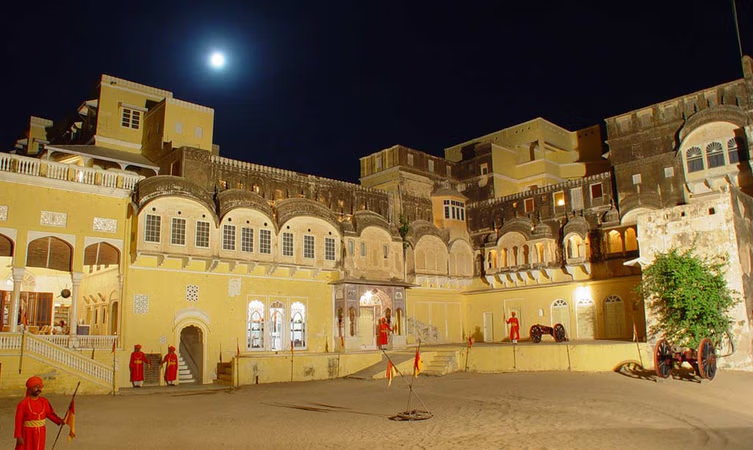Mandawa Fort, located in the heart of the Shekhawati region in Rajasthan, is a captivating testament to the grandeur and artistic prowess of the 18th century. Often referred to as an “Open Air Art Gallery,” Mandawa and its surrounding areas are renowned for their magnificent havelis (mansions) adorned with vibrant frescoes, and the fort stands as a prominent symbol of this rich heritage.
History and Construction:
The fort was built in 1755 AD (Vikram Samvat 1812) by Thakur Nawal Singh Bahadur, a descendant of the Shekhawati rulers. Its primary purpose was to protect Mandawa, which served as a crucial trading outpost on the ancient Silk Route connecting China and the Middle East. The strategic location attracted a significant community of wealthy Marwari merchants who subsequently built the elaborate havelis for which the town is famous. The fort’s construction played a pivotal role in the town’s development, providing security and attracting the thriving business community.
Architectural Marvel and Artistic Flair:
Mandawa Fort is a striking example of unique Rajasthani architecture, blending traditional Rajput elements with influences that emerged from its role as a trading hub. The fort dominates the town, identifiable by its painted arched gateway, which is famously adorned with frescoes depicting Lord Krishna and his cows.
Within the fort, the medieval theme is consistently maintained. The rooms in the palace are exquisitely decorated with beautiful frescoes, intricate carvings, and stunning mirror work. The Durbar Hall, in particular, houses a collection of antiques and paintings, offering a glimpse into the opulent lifestyle of the erstwhile rulers. The Zenana (women’s quarters) of the fort are equally impressive, with each room offering a distinct theme. One might find antique murals, another a marble fountain, and the turret room boasts walls a remarkable seven feet thick. The architectural design showcases a blend of Rajput, Muslim, and later, even colonial influences, reflecting the various periods and interactions that shaped the region.
Modern Transformation:
In recent times, Mandawa Fort has been tastefully converted into a luxurious heritage hotel, “Castle Mandawa.” This transformation allows visitors to not only explore the fort’s historical and artistic significance but also to experience royal living firsthand. The fort’s conversion has ensured its preservation, allowing its grandeur to be maintained while offering modern amenities to guests. This blend of old-world charm and contemporary comfort makes staying at the fort a truly unique experience.
Significance in Shekhawati’s “Open Art Gallery”:
Mandawa Fort’s significance extends beyond its individual structure. It is an integral part of the larger “Open Air Art Gallery” that defines the entire Shekhawati region. The frescoes on the fort’s walls, like those on the numerous havelis, tell stories of Hindu mythology, daily life, local legends, and even depict the arrival of modern innovations like cars and trains, reflecting the evolving times. The artistic style, often using natural pigments that have remarkably stood the test of time, is a testament to the skill of the local artisans.
In essence, Mandawa Fort is more than just a historical edifice; it’s a living canvas that encapsulates the artistic, cultural, and mercantile legacy of the Shekhawati region.
